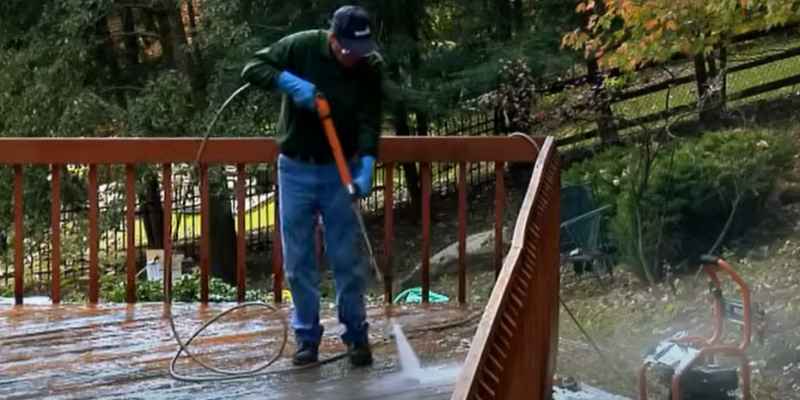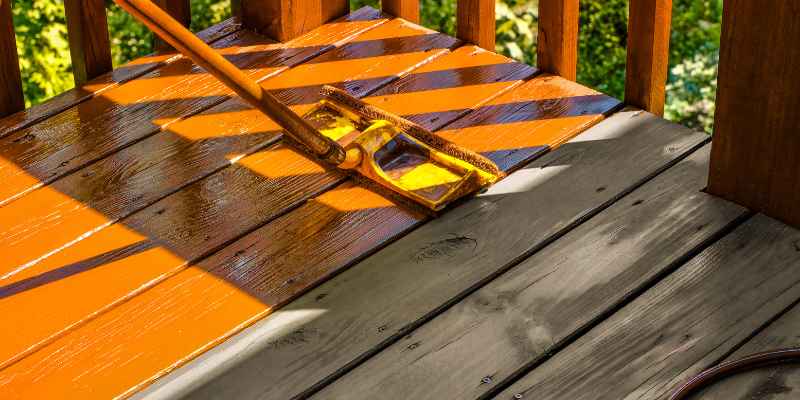Yes, it is necessary to remove old stain before restaining a deck to ensure the new stain adheres properly and achieves a consistent finish. However, before you embark on the restaining process, it’s essential to consider the current condition of your deck, the type of stain previously used, and any additional maintenance required.
Restaining a deck can provide aesthetic enhancements while protecting the wood from weathering, UV radiation, and moisture damage. By removing the old stain, you allow the new stain to penetrate the wood better and ultimately extend the lifespan of your deck.
We will explore the importance of removing old stain before restaining, as well as the steps involved in the process to help you achieve a successful deck restaining project.
Why Should You Consider Restaining Your Deck?
Restaining your deck can revitalize its appearance and protect it from the elements. While it is not always necessary to remove the old stain before restaining, proper preparation is essential to achieve the best results.
Your deck is an important investment that adds value to your home while providing a comfortable outdoor space for you and your family to enjoy. Over time, exposure to the elements can cause your deck to lose its appeal. Restaining your deck not only enhances its appearance but also offers several benefits that help protect the wood and extend the lifespan of your deck.
Enhances The Appearance Of Your Deck
Restaining your deck is a cost-effective way to breathe new life into its appearance. Over the years, the sun’s UV rays, rain, and foot traffic can cause the existing stain to fade or wear off, leaving the wood looking dull and weathered. By restaining your deck, you can restore its natural beauty and add a fresh, vibrant color that complements your outdoor space. Whether you prefer a transparent stain that allows the wood grain to show through or a solid color stain that provides a bold, opaque finish, restaining your deck can give it a rejuvenated look.
Protects The Wood From Damage
The weather can be harsh on your deck, especially if it is constantly exposed to sunlight, rain, and snow. When the existing stain wears off, the wood becomes vulnerable to damage such as cracking, warping, and rotting. By applying a new layer of stain, you create a protective barrier on the surface of the wood. The stain helps to seal the pores, preventing water from seeping into the wood and causing it to expand or contract. Additionally, a high-quality stain contains ingredients that inhibit the growth of mold, mildew, and fungi, which can degrade the wood over time. By restaining your deck, you ensure that the wood remains durable, reducing the risk of costly repairs or replacement.
Increases The Lifespan Of The Deck
Restaining your deck not only enhances its appearance and protects the wood but also extends its lifespan. The stain acts as a shield, guarding the wood against the damaging effects of moisture, UV rays, and other environmental factors. By preventing the wood from absorbing excessive moisture and blocking harmful UV rays, the stain helps to minimize the risk of decay, discoloration, and warping. This ultimately increases the longevity of your deck, allowing you to enjoy it for years to come without worrying about premature deterioration.

Factors To Consider Before Restaining A Deck
Before restaining a deck, it is important to consider whether you need to remove the old stain. Assess the condition of the current stain, check for peeling or chipping, and determine if the new stain will adhere properly without removal.
Before restaining a deck, it’s important to assess certain factors that will affect the outcome and longevity of the new stain. Taking these factors into consideration will help you decide whether you need to remove the old stain or proceed with restaining. Here are some key factors to consider before restaining a deck:
Age And Condition Of The Deck
The age and overall condition of the deck play a crucial role in determining whether old stain removal is necessary. A well-maintained and relatively new deck may not require full removal, while an older deck with wear and tear may benefit from stripping off the old stain before restaining. If the deck is structurally sound and the current stain is in good condition, you may be able to skip the removal step and proceed directly to restaining.
Type Of Stain Used Previously
The type of stain that was previously applied to your deck is another important consideration. Different stains have different composition and compatibility. Oil-based stains, for instance, penetrate deeper into the wood and may require sanding or stripping before applying a new coat. Water-based stains, on the other hand, are easier to remove and may not necessitate complete removal before restaining. Understanding the characteristics of the previous stain will help you determine the best course of action.
Extent Of Damage Or Wear
Assessing the extent of damage or wear on your deck is crucial when deciding whether to remove the old stain before restaining. If your deck has severe cracking, peeling, or discoloration, removing the old stain becomes essential. These issues can negatively impact the adhesion and durability of the new stain. However, if the damage or wear is minimal, you may be able to get away with spot treatment and touch-ups, allowing you to forego the time-consuming process of complete removal.
Desired Outcome And Aesthetics
Consider your preferred outcome and aesthetics before deciding whether to remove old stain or not. If you wish to achieve a dramatic change in color or have a specific vision for the appearance of your deck, removing the old stain is recommended. This allows you to start with a clean slate and ensures the new stain adheres properly. However, if you are content with the current look and simply want to refresh and protect the wood, you may opt to restain over the existing stain.
Advantages Of Stripping Old Stain Before Restaining
Stripping old stains before restaining your deck has several advantages. It ensures better adhesion and absorption of the new stain, resulting in a more even and longer-lasting finish. Removing the old stain also allows you to evaluate the condition of the wood and make any necessary repairs before applying the new stain.
When it comes to restaining your deck, you may wonder if it’s necessary to remove the old stain first. While it may seem like an extra step, there are several advantages to stripping the old stain before applying a new one. By taking the time to properly prepare your deck, you can ensure a longer-lasting and more attractive finish. Let’s explore the top three advantages of stripping old stain before restaining:
Improves The Adherence Of The New Stain
One of the primary advantages of stripping old stain before restaining your deck is that it improves the adherence of the new stain. Over time, the old stain can degrade, become worn, or develop areas of peeling. By stripping off the old stain, you create a clean and smooth surface, ensuring that the new stain will bond effectively. This tight bond between the deck and the new stain not only enhances the longevity of the finish but also prevents potential issues such as flaking or blistering.
Ensures A Consistent And Even Finish
Another advantage of removing the old stain is that it allows for a consistent and even finish on your deck. The previous stain may have faded or developed uneven patches due to exposure to sunlight, moisture, or foot traffic. By stripping away the old stain, you can start with a blank canvas, ensuring that the new stain goes on evenly across the entire deck. This not only improves the aesthetics of your deck but also creates a more professional and polished appearance.
Removes Any Accumulated Dirt And Grime
Over time, your deck can accumulate dirt, grime, and other contaminants that may have settled into the old stain. These particles can take away from the natural beauty of the wood and affect the overall finish of the new stain. By stripping off the old stain, you can effectively remove any accumulated dirt and grime, allowing the new stain to highlight the true beauty of the wood. This ensures that your deck looks fresh, clean, and rejuvenated after the restaining process.
Allows For Better Evaluation Of Deck’s Condition
Stripping the old stain not only prepares the deck for a new finish but also provides an opportunity to evaluate the condition of the wood. During the stripping process, you can closely examine the deck for any signs of damage or wear, such as rot, cracks, or loose boards. Identifying these issues beforehand allows you to address them and make any necessary repairs before applying the new stain. By ensuring that your deck is in good condition, you can extend its lifespan and maintain its structural integrity.
When Stripping Old Stain Is Not Necessary
When it comes to restaining a deck, many homeowners wonder whether they need to remove the old stain before applying a new one. While stripping old stain can be a necessary step in some cases, there are instances where it is not required. In this article, we will explore when stripping old stain is not necessary and the factors you should consider. So, let’s dive in and discover if you can save time and effort by skipping this step!
The Old Stain Is In Good Condition
If the old stain on your deck is still in good condition, with no signs of peeling, flaking, or severe discoloration, then you may not need to strip it off. Instead, you can begin restaining by ensuring the surface is clean and free from dirt, debris, and mold. A quick wash with a mild detergent and water can be effective in preparing the surface for a fresh coat of stain.
Using A Compatible Stain
Another important factor to consider before deciding whether to strip the old stain is the compatibility of your new stain. If the old and new stains are compatible, meaning they are from the same brand or type and can be mixed together without any adverse effects, then you may be able to apply the new stain directly over the old one. Ensure to check the manufacturer’s instructions or consult with a professional to confirm compatibility.
Light Surface Preparations Will Suffice
In certain cases, where the old stain is only slightly worn or faded, light surface preparations may be sufficient to achieve satisfactory results. This can involve lightly sanding the deck surface to remove any rough spots and create a slightly roughened surface for enhanced stain adhesion. After sanding, make sure to remove any dust and debris before applying the new stain.
Time And Economic Factors
In addition to the condition of the old stain and the compatibility of the stains, it is important to consider time and economic factors. Stripping old stain can be a labor-intensive and time-consuming process, requiring specialized chemicals and tools. If you are on a tight schedule or have budget constraints, skipping this step may be a viable option, as long as the old stain is in good condition and the new stain is compatible.
In conclusion, stripping old stain before restaining a deck is not always necessary. If the old stain is in good condition, the new stain is compatible, and you perform light surface preparations, you can potentially save time and effort. Consider the factors discussed in this article and make an informed decision based on the condition of your deck, the type of stain you want to use, and your time and budget constraints. Happy restaining!

Tips For Stripping Old Stain And Restaining A Deck
To achieve a successful deck restaining, it is recommended to remove the old stain beforehand. By stripping the old stain, you ensure a clean and even surface, allowing the new stain to adhere effectively, resulting in a more durable and attractive finish.
Choosing The Right Stripping Product
When it comes to stripping old stain from your deck, choosing the right stripping product is crucial. You want a product that is effective yet gentle enough to protect the underlying wood. Look for a stripper specifically designed for deck staining removal.
Prepping The Deck For Stripping
Before applying the stripping product, it is important to prep the deck. Start by removing any furniture, plants, or other items from the deck. Then, sweep away any loose debris and use a power washer or a garden hose with a high-pressure nozzle to thoroughly clean the deck surface. This will ensure that the stripping product can penetrate the old stain effectively.
Applying The Stripping Product
Once the deck is prepped, it’s time to apply the stripping product. Follow the manufacturer’s instructions carefully, as different products may have different application methods. Use a paintbrush, roller, or sprayer to evenly apply the stripper to the deck surface. Make sure to work in manageable sections to avoid the product drying before you can remove the old stain.
Removing The Old Stain
After allowing the stripping product to sit for the recommended amount of time, it’s time to remove the old stain. Use a stiff-bristle brush or a pressure washer with a low-pressure nozzle to scrub away the old stain. Work in small sections, applying even pressure to ensure thorough removal. Take care not to damage the wood during this process.
Cleaning And Preparing The Deck For Restaining
Once the old stain is removed, it’s important to clean and prepare the deck for restaining. Rinse the deck thoroughly with water to remove any remaining stripping product. Allow the deck to dry completely before proceeding. This may take several days, depending on weather conditions.
Applying The New Stain
Now that the deck is clean and dry, you can apply the new stain. Choose a high-quality deck stain that matches your desired color and provides UV protection. Use a paintbrush, roller, or sprayer to apply the stain evenly, working in the direction of the wood grain. Allow the stain to dry according to the manufacturer’s instructions before walking on or placing furniture back on the deck.
Remember, following these tips and taking the time to properly strip and restain your deck will not only enhance its appearance but also prolong its lifespan. By investing a little extra effort upfront, you can enjoy a beautiful and well-maintained deck for years to come.
Conclusion
To ensure a successful deck restaining project, don’t overlook the importance of removing old stain. By taking the time to thoroughly clean and strip the deck, you’ll achieve better adhesion and longevity for the new stain. Removing old stain allows the new stain to penetrate and enhance the natural beauty of the wood.
So, before you begin restaining, make sure to properly prepare your deck for optimal results. Your deck will thank you with a fresh, vibrant finish that will last for years to come.


